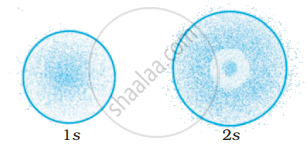Advertisements
Advertisements
प्रश्न
The arrangement of orbitals on the basis of energy is based upon their (n + l) value. Lower the value of (n + l), lower is the energy. For orbitals having same values of (n + l), the orbital with lower value of n will have lower energy.
Based upon the above information, arrange the following orbitals in the increasing order of energy.
1s, 2s, 3s, 2p
उत्तर
| Orbitals | s | p | d | f |
| l | 0 | 1 | 2 | 3 |
| Orbitals | n | n + l |
| 1s | 1 | 1 |
| 2s | 2 | 2 |
| 3s | 3 | 3 |
| 2p | 2 | 3 |
Thus the increasing order of energy is 1s < 2s < 2p < 3s
APPEARS IN
संबंधित प्रश्न
Choose the correct option.
“No two electrons in the same atoms can have identical set of four quantum numbers”. This statement is known as -
State Hund’s rule of maximum multiplicity with a suitable example.
Draw shapes of 2s orbitals.
Draw shapes of 2p orbitals.
The designation of a subshell with n = 6 and l = 2 is ____________.
Which one of the following orders is CORRECT in case of energy of the given subshells?
P: n = 4; l = 3
Q: n = 5; I = 1
R: n = 5; l = 0
S: n = 4; l = 2
How many electrons can fit in the orbital for which n = 4 and l = 2?
The probability density plots of 1s and 2s orbitals are given in Figure:

The density of dots in a region represents the probability density of finding electrons in the region.
On the basis of above diagram which of the following statements is incorrect?
The arrangement of orbitals on the basis of energy is based upon their (n + l) value. Lower the value of (n + l), lower is the energy. For orbitals having same values of (n + l), the orbital with lower value of n will have lower energy.
Based upon the above information, arrange the following orbitals in the increasing order of energy.
4s, 3s, 3p, 4d
Which of the following is not the permissible arrangement of electrons in an atom?
